Genetically engineered crops in the USA
Genetically engineered (GE) crops have been widely adopted by U.S. farmers since their introduction in 1996, notwithstanding uncertainty about consumer acceptance and economic and environmental impacts.
Genetically modified crops have been developed in order to make cultivations easier, to increase yield or to create varieties with better aesthetic, nutritional, gustatory or preservation characteristics.
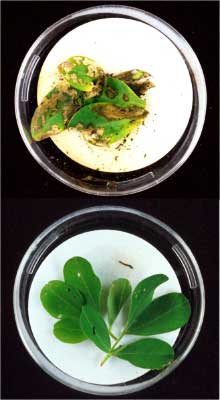 Herbicide-tolerant (HT) crops were developed to resist application of non-selective herbicides, which kill all plant material they come into contact with. The modified plant is therefore the only one that can survive, even after large spreading of the herbicide. HT soybeans went from 17% of U.S. soybean acreage in 1997 to 92% in 2008. Plantings of HT cotton expanded from about 10% of U.S. acreage in 1997 to 68% in 2008. The adoption of HT corn, which had been slower in previous years, has accelerated, reaching 63% of U.S. corn acreage in 2008.
Herbicide-tolerant (HT) crops were developed to resist application of non-selective herbicides, which kill all plant material they come into contact with. The modified plant is therefore the only one that can survive, even after large spreading of the herbicide. HT soybeans went from 17% of U.S. soybean acreage in 1997 to 92% in 2008. Plantings of HT cotton expanded from about 10% of U.S. acreage in 1997 to 68% in 2008. The adoption of HT corn, which had been slower in previous years, has accelerated, reaching 63% of U.S. corn acreage in 2008.
Insect-resistant crops containing the gene from the soil bacterium Bt (Bacillus thuringiensis) have been available for corn and cotton since 1996. These bacteria produce a protein that is toxic to specific insects, protecting the plant over its entire life. Plantings of Bt corn grew from about 8% of U.S. corn acreage in 1997 to 57% in 2008. Plantings of Bt cotton expanded more rapidly, from 15% of U.S. cotton acreage in 1997 to 63% in 2008. Insects have not posed major problems for soybeans, so insect-resistant varieties have not been developed.
Top: Lesser cornstalk borer larvae extensively damaged the leaves of this unprotected peanut plant.
Bottom: After only a few bites of peanut leaves of this genetically engineered plant (containing the genes of the Bacillus thuringiensis (Bt) bacteria), this lesser cornstalk borer larva crawled off the leaf and died - Source: Agricultural Research magazine
In 2007, the USA continued to be the principal adopters of biotechnological crops globally. USA retains its top world ranking with 57.7 million hectares (i.e. 50% of global GE crops area) spurred by a growing market for ethanol with the biotech maize area increasing by a substantial 40%.
It is worth noting that 63% of GE maize, 78% of GE cotton, and 37% of all GE crops in the USA in 2007 were stacked products. Stacked varieties contain 2 or 3 traits, for example varieties of cotton and corn have been developed to have both Ht and Bt traits. Adoption of stacked varieties has accelerated and these are now increasingly deployed by ten countries – USA, Canada, the Philippines, Australia, Mexico, South Africa, Honduras, Chile, Colombia, and Argentina, with more countries expected to adopt them in the future.
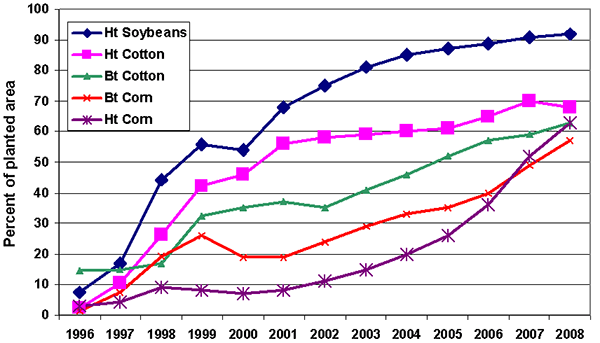
Rapid growth in adoption of genetically engineered crops in USA. Data for each crop category include varieties with both HT (Herbicide-tolerant) and Bt (Insect-resistant - stacked) traits - Source: USDA 2008
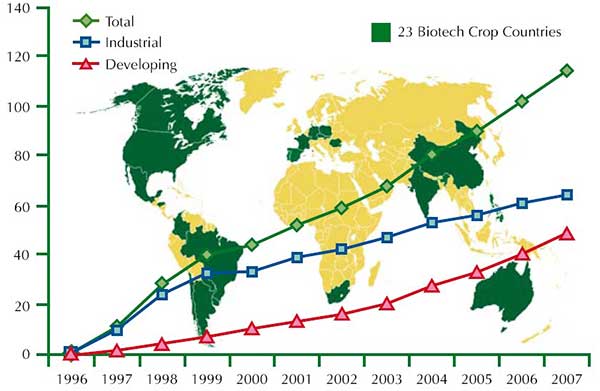
Global area of biotech crops (million hectares). The figure shows an increase of 12% - 12.3 million hectares - between 2006 and 2007. Source: Clive James, 2007
Controversies
Many major controversies surround genetically engineered crops and foods. These commonly focus on the long-term health effects for anyone eating them. The main concerns relate to the possibility of increased allergens, toxins and other harmful compounds, but also to the horizontal gene transfer, particularly of antibiotic-resistant genes, which were used for number of GE crops of the first generation. If these genes were to be transferred from a foodstuff into human cells or into gastrointestinal bacteria, it could lead to the development of bacteria stocks resistant to antibiotics, with adverse health consequences.
Releasing transgenic crops into the environment may have direct or indirect effects. As direct effect, we can fear genes transfer to wild relatives or conventional crops. Some transgenic traits may affect non-target species as well as the crop pests they are intended to control (for example there was a controversy about the effect of pesticidal toxins Bt on monarch butterfly). Moreover, extensive long-term use of crops expressing insecticidal substances can promote the development of resistant insect pests.
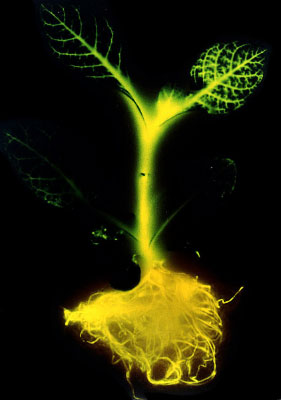
An image of a tobacco plant which has been genetically engineered to express a gene taken from fireflies which produces luciferase. When the plant is watered with a luciferin containing nutrient medium, tissue specific luminescence is observed. It is the first representation of a transgenic multicellular organism expressing bioluminescence. Source: Image taken by K Woodfor Science Magazine
Other effects are linked to the modification of agricultural practices. The use of transgenic insect-resistant Bt crops is reducing the volume and frequency of insecticide use on maize, cotton and soybean. On the other hand, the adoption of herbicide-tolerant (HT) crops leads to an increase in total herbicide use (even if there has been a marked shift away from more toxic herbicides to less toxic forms).
By standardizing agricultural practices, GE crops may also threaten biodiversity and disrupt the socio-economic balance.
The multi-national companies and governments engaged in the genetic engineering of food claim the technology to be a boon for the human race, while many health-conscious people believe it to be a potential and/or actual disaster. Consumer rights groups claim worldwide that the risks of GE foods have not yet been adequately investigated and open the debate on numerous questions linked to environmental safety and conservation, food security, labelling and consumer choice, intellectual property rights, ethics,...
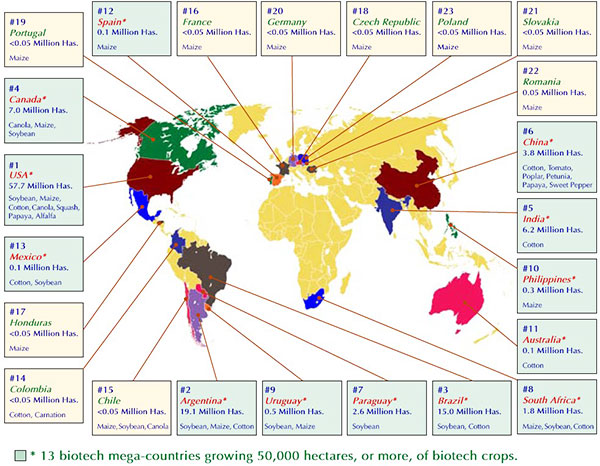
Biotech crop countries and mega-countries - Source: Clive James, 2007
Sources
Adoption of Genetically Engineered Crops in the U.S. - USDA
Global Status of Commercialized Biotech/GM Crops: 2007 - ISAAA Briefs
Global Status of Commercialized Biotech/GM Crops: 2007 - ISAAA Brief 37-2007: Executive Summary
The State of Food and Agriculture 2003-2004 Agricultural Biotechnology Meeting the needs of the poor? - FAO
Wikipedia Genetically modified food
This page was written in 2009, as additional information to the poster series "10 years of Imaging the Earth"